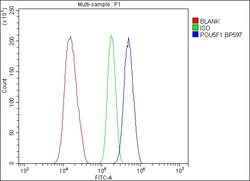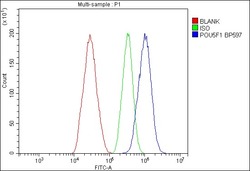Antibody data
- Antibody Data
- Antigen structure
- References [4]
- Comments [0]
- Validations
- Flow cytometry [1]
Submit
Validation data
Reference
Comment
Report error
- Product number
- A00174-1 - Provider product page

- Provider
- Boster Biological Technology
- Product name
- Anti-Oct4/POU5F1 Antibody
- Antibody type
- Polyclonal
- Description
- Rabbit IgG polyclonal antibody for Oct4/POU5F1 detection. Tested with WB, FCM, Direct ELISA in Human;Mouse;Rat.
- Reactivity
- Human, Mouse, Rat
- Host
- Rabbit
- Vial size
- 100μg/vial
- Concentration
- Add 0.2ml of distilled water will yield a concentration of 500ug/ml.
- Storage
- At -20°C for one year. After reconstitution, at 4°C for one month. It can also be aliquoted and stored frozen at -20°C for a longer time. Avoid repeated freezing and thawing.
- Handling
- Add 0.2ml of distilled water will yield a concentration of 500ug/ml.
Submitted references Angiotensin (1-7) reverses glucose-induced islet β cell dedifferentiation by Wnt/β-catenin/FoxO1 signalling pathway.
LncRNA LINC00662 Exerts an Oncogenic Effect on Osteosarcoma by the miR-16-5p/ITPR1 Axis.
Insulin-like growth factor binding protein 4 enhances cardiomyocytes induction in murine-induced pluripotent stem cells.
Knockdown of OCT4 suppresses the growth and invasion of pancreatic cancer cells through inhibition of the AKT pathway.
Guo D, He J, Guo H, Song G, Peng L, An M, Wang C
Endokrynologia Polska 2023;74(5):544-552
Endokrynologia Polska 2023;74(5):544-552
LncRNA LINC00662 Exerts an Oncogenic Effect on Osteosarcoma by the miR-16-5p/ITPR1 Axis.
Yu M, Lu W, Cao Z, Xuan T
Journal of oncology 2021;2021:8493431
Journal of oncology 2021;2021:8493431
Insulin-like growth factor binding protein 4 enhances cardiomyocytes induction in murine-induced pluripotent stem cells.
Xue Y, Yan Y, Gong H, Fang B, Zhou Y, Ding Z, Yin P, Zhang G, Ye Y, Yang C, Ge J, Zou Y
Journal of cellular biochemistry 2014 Sep;115(9):1495-504
Journal of cellular biochemistry 2014 Sep;115(9):1495-504
Knockdown of OCT4 suppresses the growth and invasion of pancreatic cancer cells through inhibition of the AKT pathway.
Lin H, Sun LH, Han W, He TY, Xu XJ, Cheng K, Geng C, Su LD, Wen H, Wang XY, Chen QL
Molecular medicine reports 2014 Sep;10(3):1335-42
Molecular medicine reports 2014 Sep;10(3):1335-42
No comments: Submit comment
Supportive validation
- Submitted by
- Boster Biological Technology (provider)
- Main image

- Experimental details
- Flow Cytometry analysis of 293T cells using anti-POU5F1 antibody (A00174-1). Overlay histogram showing 293T cells stained with A00174-1 (Blue line).The cells were blocked with 10% normal goat serum. And then incubated with rabbit anti-POU5F1 Antibody (A00174-1,1μg/1x106 cells) for 30 min at 20°C. DyLight®488 conjugated goat anti-rabbit IgG (BA1127, 5-10μg/1x106 cells) was used as secondary antibody for 30 minutes at 20°C. Isotype control antibody (Green line) was rabbit IgG (1μg/1x106) used under the same conditions. Unlabelled sample (Red line) was also used as a control.
- Additional image

 Explore
Explore Validate
Validate Learn
Learn Western blot
Western blot Flow cytometry
Flow cytometry